Page 6 of 9
Re: Max Anderson
Posted: Wed Jun 01, 2022 7:21 am
by Max Anderson
Thanks Both,
I've become more fond of Devil's dyke, particularly given how local it is. I've been trying to become more familiar with my local sites, reducing mileage where possible and avoiding driving altogether when I can, so it's also handy to have such a reliable site that is easily accessible by bus.
I do find the in-flight shots to be very satisfying. I'll share some more recent ones in the next few days, that I particularly enjoyed!
Re: Max Anderson
Posted: Wed Jun 01, 2022 4:33 pm
by Max Anderson
Portugal
In late April, I was fortunate enough to be able to teach on a Mediterranean field course for some Masters and Undergraduate students. We spent 6 days in Arrifana, a well reputed surfing hotspot on the west coast of southern Portugal. While I spent most of the week teaching sampling methodologies, shadowing students during their projects, and running some bat surveys, I managed to find some time here and there to make some rewarding observations.
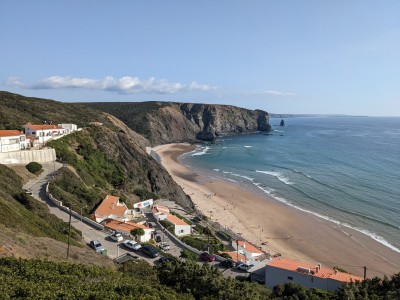
- Arrifana
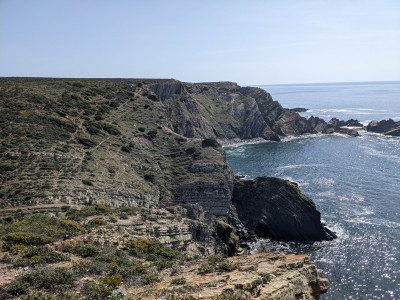
- Arrifana
On the first day, after getting our bearings in the local area, I spotted a Southern Scarce Swallowtail in a small patch of scrub, adjacent to the student accommodation.
By far, the most frequently recorded species across the entire week was Green hairstreak. Particularly in the coastal dunes, there were hundreds of individuals, with particular hotspots along paths, where the males could occupy perches and establish territories. I’m aware that Chapman’s is present in the area, however I didn’t come across any in my searches.
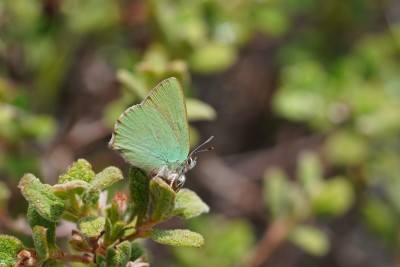
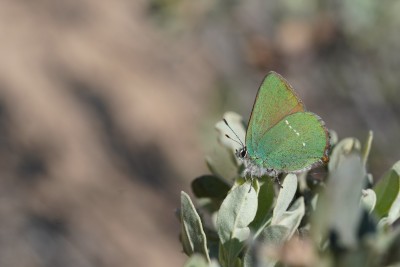
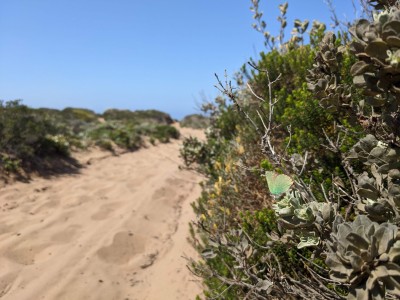
Along the coast, there are a few pairs of White Storks nesting on the cliffs, and with some student projects exploring their behaviour, I had a good amount of time to explore the cliff tops. A number of long-tailed blues were occupying a patch of vegetation with Iberian milk-vetch in abundance. Unfortunately, I was arriving towards the end of the flight period for the Provence hairstreak, which also uses Iberian milk-vetch as a food plant, and was unable to find any signs of this species. In contrast, the long-tailed blues were particularly active in this area, with high densities of eggs being laid in very close proximity to the cliff edge.
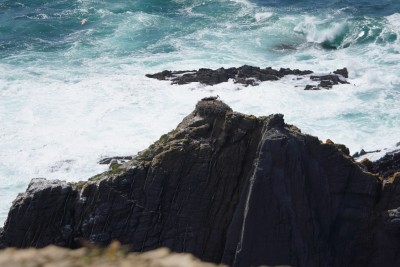
- Storks nesting with chicks
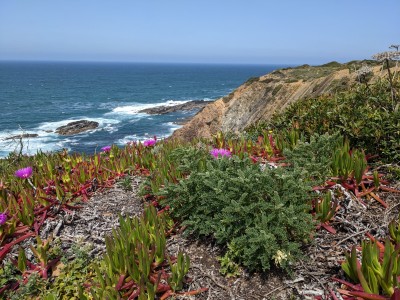
- Cliff tops
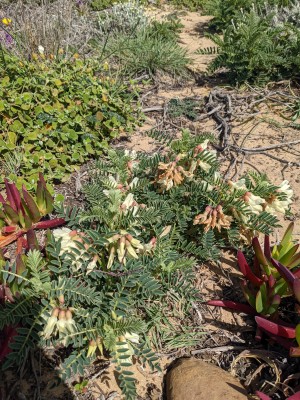
- Iberian Milk Vetch
The paths emanating away from the coastal cliffs provide ample perching opportunities for a wide range of species to occupy. On walking back to the accommodation one afternoon, I came across a particularly busy path, where I found black-eyed blues being pestered by green hairstreaks.
Small coppers were also seen quite frequently, and much like the green hairstreak, they were often found along some of the well defined coastal paths, and in the denser vegetation further inland in the river valleys.
As a designated driver, I was tasked with dropping off some students to the estuary to study fiddler crab behaviour in response to human disturbance. I was lucky to get within a few metres of some male fiddler crabs, though they require far more patience to photograph than butterflies. The paths leading to the estuary provide a different habitat type to the majority of the coastal dunes, with dense patches of spiny thrift serving as the host plant of
Cyaniris semiargus tartessus, a subspecies of the Mazarine blue, which is endemic to the southern Iberian Peninsula. While waiting to collect the students one afternoon, I found a mating pair, darting around some spiny thrift. After watching them for 5 minutes, they then separated and basked in the sun, before flying off.
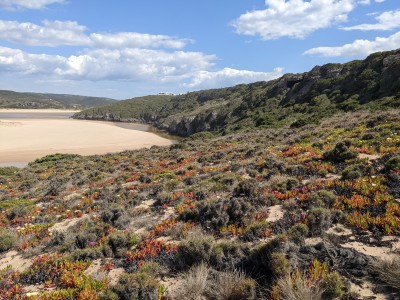
- Estuary
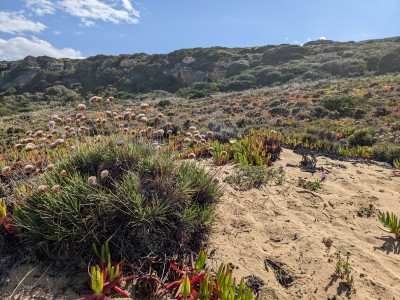
- Spiny thrift
Towards the end of the field course, I spent a little more time inland, with some students looking at the impact of the highly invasive sour fig, Carpobrotus edulis, on ground flora and pollinator activity. I discovered some patches of dense vegetation along the river valleys, where the increase in shelter provided improved conditions for a few other species. To my surprise and delight, I stumbled across a blue-spot hairstreak, perching from sage-leaved rock rose, and occasionally occupying some small stands of Mediterranean buckthorn. According to ‘Butterflies of the Iberian Peninsula’, adults are on the wing from mid-May through to late July, and so a record at the end of April was a nice surprise.
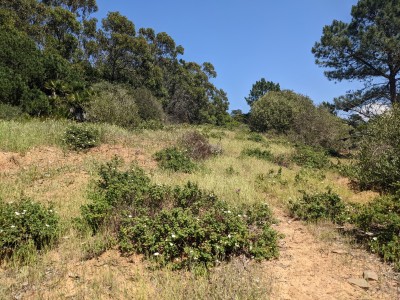
- Valley habitat
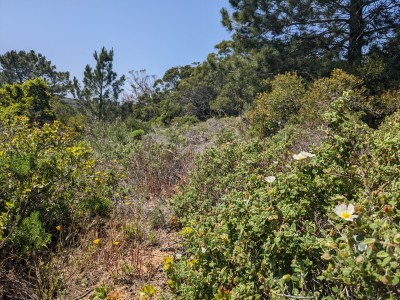
- Sage-leaved rose and Mediterranean buckthorn in valley habitat
Re: Max Anderson
Posted: Fri Jun 03, 2022 4:56 pm
by David M
Some great images there, Max. Mr Padfield has competition!!
Looks like you had better weather than I did in southern Spain at the same time.
Re: Max Anderson
Posted: Fri Jun 03, 2022 6:18 pm
by Wurzel
Fantastic to see all those foreign species Max


I wouldn't have expected Storks to nest on cliffs - they seem a bit cumbersome for that

COnggrats on finishing your PhD

Have a goodun
Wurzel
Re: Max Anderson
Posted: Fri Jun 03, 2022 8:27 pm
by Max Anderson
Thanks both,
Guys images are a great source of inspiration for me and many others. I think there’s a lot of skill involved in not only capturing an image that includes both the species but also its habitat and occasionally some added context or behaviour, whilst minimising any disturbance or damage to the habitat. I much prefer the challenge of these types of shots compared with the more conventional butterfly shots that we’re all very familiar with.
Thanks Wurzel, much appreciated! I do enjoy branching out into Europe, but the next posts will be back in the UK..
Re: Max Anderson
Posted: Sat Jun 04, 2022 8:15 am
by Katrina
Your second last shot is brilliant. Great to see the butterfly in habitat.
Re: Max Anderson
Posted: Sun Jun 05, 2022 8:00 am
by Benjamin
Sounds like a great trip Max, and your usual style of including plenty of habitat info and context shots really brings the report to life - fascinating stuff.
Re: Max Anderson
Posted: Sun Jun 05, 2022 6:16 pm
by Max Anderson
Thanks both, much appreciated.
Anchor bottom
I visited Anchor bottom a week or so ago. I know the site to be particularly good for Adonis Blues, where they can be found in their hundreds and thousands. Cow pats and other sources of dung can be covered in males. I walked along the slopes, saw countless females nectaring and spent a good hour or two watching males congregating and battling after being disturbed.
I had a play with my camera to try and capture more in-flight action and was quite pleased with some of the results! I ended up with around 40-50 images like the ones below, each of which have something new and unique about them. Capturing the some of the bizzare and contorted positions that they find themselves in during flight adds to the magic!
There were also around 7 or 8 Painted ladies, as well as some fresh brown argus towards the bottom of the slopes, but watching the Adonis took up all of my time.
Re: Max Anderson
Posted: Sun Jun 05, 2022 6:21 pm
by Katrina
Your mass in flight photos are amazing , especially the second last of your photos. So many in focus!


Re: Max Anderson
Posted: Sun Jun 05, 2022 7:15 pm
by trevor
Amazing Blues in flight shots Max. The last time I saw some shots of
so many Blues they were settling in the grass. At the same location I believe.
Great photography,
Trevor.
Re: Max Anderson
Posted: Sun Jun 05, 2022 9:12 pm
by millerd
Those shots of the Adonis in flight are terrific, Max.

It's almost impossible to convey the feeling of walking amongst multiple butterflies like that, but you've really succeeded there. Magical.

Dave
Re: Max Anderson
Posted: Mon Jun 06, 2022 2:04 pm
by PhilM
I have particularly enjoyed reading your PD Max. I like your informative way of writing and the many excellent photographs. It is nice to see the habitat shots alongside the butterflies. Thanks,
Phil.
Re: Max Anderson
Posted: Mon Jun 06, 2022 2:19 pm
by Pauline
I'm with the others on this Max - something a bit special about those in flight shots especially second last. Having tried it myself recently with just 2, I know how difficult that is.
Re: Max Anderson
Posted: Mon Jun 06, 2022 9:14 pm
by bugboy
As others have said, superb in flight shots of those Adonis

Re: Max Anderson
Posted: Mon Jun 06, 2022 9:22 pm
by Wurzel
Brilliant to see those in flight shots Max - some of the shapes they throw is amazing and some of them look a little like birds in flight


Have a goodun
Wurzel
Re: Max Anderson
Posted: Tue Jun 07, 2022 12:36 pm
by Max Anderson
Thank you all for the kind comments - much appreciated!
It took some patience and a considerble amount of tweaking to get things in focus.
Re: Max Anderson
Posted: Wed Jun 08, 2022 2:35 pm
by David M
There's a serene beauty in those in-flight images, Max. You've perfected your craft superbly.
That first image is almost 'Barn owl' with the fluffy white body and the raised wings.
Re: Max Anderson
Posted: Sat Jun 11, 2022 5:04 pm
by Max Anderson
Rather than repeat what Pete Eeles has already said in his PD, and share some photos of the same individuals - thought I'd just chip in with some slightly different images from the day with Large blues. By my count, we had at least 25 individuals, with some newly emerged females, a few mating pairs and plenty of egg laying going on. We were quite lucky with the weather - a good mix of sun and cloud, providing a few opportunities to capture some open wing shots.
Re: Max Anderson
Posted: Sat Jun 11, 2022 7:33 pm
by Pete Eeles
Great to finally meet you, Max, and I really enjoyed the chats we had - very thought-provoking! You have some great images there - and "in context" shots are yet another thing I typically forget (along with general habitat shots) when on site - shame on me!
I look forward to our next encounter!
Cheers,
- Pete
Re: Max Anderson
Posted: Sun Jun 12, 2022 9:35 am
by Max Anderson
Thanks Pete - I'm getting better at including more contextual shots in my blogs - they give so much more information than the flat on macro shots, and I think they're crucial for story-telling.